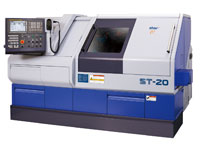Introducing the Swiss Type Automatic Lathe ST-20
With ø20mm-type Added to 3-Turret Complex Machine Model ST
Features of ST-20
High productivity
- Star Motion Control System for reduction of non-cutting time.
- Simultaneous machining by opposing turret-type tool post for reduction of machining time.
- The turret-type tool post for back-side machining to achieve simultaneous machining on both the front and back sides.
High accuracy
- Suppressed thermal displacement of the main/sub spindles by spindle cooling unit.
- Cutting oil cooling unit mounted as standard to suppress the thermal displacement caused by heat generation from rotary tools and temperature rise of cutting oil.
- Star Motion Control System to achieve smooth axis movement control and restrain machine vibration.
Machining capability
- Turret-type tool post for back-side machining achieves complex machining equally on both the front and back sides.
- A variety of tool units to be mounted on the turret-type tool post for machining complicated parts.
- The headstock stroke of 3500mm allows machining of bar materials.
Major Specifications
| Max. machining diameter | ø20mm | ||
|---|---|---|---|
| Max. headstock stroke | 350mm | ||
| Max. main spindle speed | 10000 min-1 | ||
| Main spindle motor | 3.7kw / 5.5kw (built-in motor) | ||
| Max. sub spindle speed | 10000 min-1 | ||
| Sub spindle motor | 3.7kw / 5.5kw (built-in motor) | ||
| Tool post specifications | Front side | 8-stationed turret-type tool post | 2 units |
| Tool | Max. 3 tools/station (□12mm) | ||
| Sleeve | Max. 3 sleeves / station | ||
| Power tool | Max. 2 tools / station | ||
| Max. power tool rotation speed | 5750min-1 | ||
| Power tool motor | 2.5kw | ||
| Back side | 8-stationed turret-type tool post | 1 units | |
| Tool | Max. 3 tools/station (□12mm) | ||
| Sleeve | Max. 3 sleeves / station | ||
| Power tool | Max. 2 tools / station | ||
| Max. power tool rotation speed | 5750min-1 | ||
| Power tool motor | 2.5kw | ||
| Machining capability | Stationary tool | Max. drilling capability | ø14mm |
| Max. tapping capability | M10 × P1.5 | ||
| Power tool | Max. drilling capability | ø8mm | |
| Max. tapping capability | M6 × P1.0 | ||
| Machine dimensions (W x D x H) | 2988 × 1720 × 1845 mm | ||
NOTE 1: Swiss-type automatic lathe
The Swiss-type automatic lathe was devised as watch component processing machinery in Switzerland in 1870s. Known as a “sliding head-type automatic lathe” as well, it has remarkable characteristics of high-precision cutting of components with longer length compared with the diameter.
In general, if long and narrow parts are processed with a general-purpose lathe, flexure will occur on the workpiece, making finishing with the correct dimensions impossible. The Swiss-type automatic lathe utilizes a guide bush to function as a material steady rest. The tool, positioned at a certain distance from the guide bush, gives a cutting motion only the direction of outside diameter. This allows the workpiece to be cut accurately with no flexure. As for axial motion, the headstock, rather than the tailstock, moves while clamping a workpiece.
NOTE 2: Star Motion Control System
General machining, when NC-controlled, is composed of the following processes:
[Tool selection] → [Approach] → [Cutting] → [Disengagement] → [Next tool selection] → [Approach] → [Next cutting]
In this process, functions other than actual cutting largely affect the machining time. The Star Motion Control System is a function to reduce this non-cutting time.
The Star Motion Control data can be created easily by NC program conversion through “optimization”.
This “optimization” finishes processing related the switching of control systems and completes the processes of [Tool selection] and [Approach] during the process of [Cutting], and the [Disengagement] process of the tool and the next [Cutting] process are controlled to start at the same time. By this control method, the time required for the processes of [Disengagement], [Next tool selection] and [Approach] can be minimized to reduce the non-cutting time.

